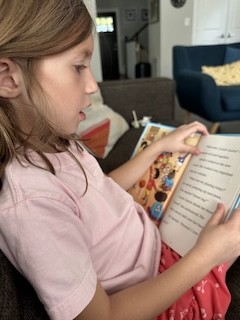Blast from the Past: First posted April 12, 2014, re-posted on November 1, 2017. This issue of how much reading students should do in class continues to be a hot issue. Today, I'd go even further than I did then. I now counsel that 50% of reading comprehension time should be spent reading (and, similarly a big chunk of the time devoted to social studies and science text should be spent that way, too). I'd call for the same thing in phonics/decoding time (spending about half the time decoding and encoding words), fluency (about half the time reading aloud), and writing (half the time creating text). But, no, I would not devote a lot of instructional time to having kids reading self-selected texts on their own for enjoyment; that's not a good use of school time.
Teacher question:
I am wondering what you think are the acceptable ways to read text in a text in grades 3-8. Obviously, round robin or popcorn reading is not one of them -- and these are still options we see too often. Independent reading is desired, and some degree of teacher read aloud to the whole class to model fluency and dramatic reading is appropriate as well. What other ways do you think are effective? How much time would you say we should push teachers to do each? (i.e. 60% independent, 20% teacher read aloud...) etc.
Shanahan response:
I’m with those who believe that students need to read a lot during their school days. Yes, they should read at home, but within their schoolwork at school in class, students need lots of opportunities and requirements to read.
The most powerful of such reading (in terms of stimulating student learning) seems to be oral reading with feedback from a teacher. I would discourage popcorn or round robin but not because the reading practice that they provide is so bad—just that they provide so little practice. When one student is reading, many more are just sitting waiting for their turn. The students who are reading are learning, and the others, not so much.
Research suggests that techniques like paired reading (in which kids read and reread texts to each other), reading while listening, echo reading, radio reading, etc. can all be good choices. In all of these techniques, many students are able to practice simultaneously, they read relatively challenging materials, and then they reread these in an effort to improve the quality. If students can read texts (8th grade or higher) orally at about 150 words correct per minute, I wouldn’t bother with this kind of practice, and if they could not, I would provide about 30 minutes of it each school day.
As powerful as oral reading is at stimulating student reading ability, we can’t ignore the fact that most reading that we engage in will be silent, and students need to practice this as well. I would strongly encourage teachers to have students read those texts silently that they are to write about or that are going to be the focus of group or class discussion. When I assign such reading in classrooms, kids often tell me that I’m doing it wrong (because their teachers have them read the texts round robin). Teachers do this to make sure kids read it and to monitor their reading. By doing the fluency work noted above, I do away with the need to monitor their fluency progress (I’m already doing that), and teachers can make sure students read from the discussions and writing that ensues. I would usually have students reading their literature selection and their social studies or science chapters silently. If students struggle with this, divide the assignments into shorter chunks (even 1 page at a time), and then stretch this out over time. I would suggest that students should be engaging in as much silent reading as oral reading in these grades (and if students are fully fluent as described above, then the silent reading should be almost 100% of what students read).
I would argue not only for minutes to be dedicated to fluency practice but for another 30-45 minutes to focus on reading comprehension daily—and a lot of this time would entail silent reading. However, silent reading is also going to come up during science, social studies, and other subjects and this counts, too. Thus, having students spend as much as 15 minutes reading aloud (paired reading for 30 minutes would allow each student 15 minutes of such practice), and having students read for 20-30 minutes of a 45 minute comprehension lesson and reading another 10-20 minutes a day in other subjects would give kids a substantial amount of oral and silent reading practice.
Even in the silent reading context, there should be at least some oral reading. Most prominently: students should read aloud during discussions to provide evidence supporting their claims or refuting someone else’s.
It is a good idea to encourage kids to read on their own, but this has such a small impact on student learning that I would make such opportunities available in ways that would not appreciably reduce the instructional doses suggested above. Getting kids to read on their own beyond the school day while providing them with the heavy involvement in reading across their school day will be the most powerful combination for getting students to high-performance levels.






Comments
See what others have to say about this topic.